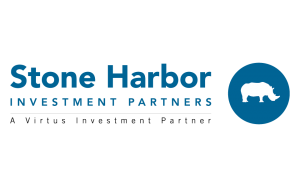Virtus Stone Harbor Emerging Markets Debt Income Fund
Virtus Stone Harbor Emerging Markets Debt Income Fund
Investment Overview
The Fund seeks to maximize total return, which consists of income on its investments and capital appreciation, by investing in a portfolio of emerging markets debt instruments.

Virtus Stone Harbor Emerging Markets Debt Income Fund (I:SHMDX)
Best International Bond Funds (out of 90 international bond funds)
IBD uses the following methodology each year to compile the IBD Best Mutual Funds report: Using data provided by Morningstar, IBD looks at all the mutual funds with at least a 10-year track record. From this, the total number of eligible funds are determined. Eligible funds are those open at least 10 years. The winning funds are only those that outperform their benchmark for the past one, three, five, and 10 years. Morningstar rankings are not used in the methodology.
Morningstar’s data does not factor in sales charges or waivers.
All investments carry a certain degree of risk, including possible loss of principal.
Investment Partner
Stone Harbor Investment Partners
Stone Harbor Investment Partners is an emerging markets debt manager with three decades of informed experience allocating risk in complex areas of the fixed income markets.
Stone Harbor Investment Partners is a division of Virtus Fixed Income Advisers, LLC ("VFIA"), an SEC registered investment adviser.
Learn more about Stone Harbor Investment Partners
Investment Professionals
Peter J. Wilby, CFA
Co-Chief Investment Officer of SHIP Strategies
Industry start date: 1980
Start date as fund Portfolio Manager: 2007

James E. Craige, CFA
Co-Chief Investment Officer, Head of Emerging Markets
Industry start date: 1988
Start date as fund Portfolio Manager: 2007

Stuart Sclater-Booth
Portfolio Manager, Emerging Markets Debt, Global Sovereign, and Asset Allocation
Industry start date: 1992
Start date as fund Portfolio Manager: 2017
Kumaran Damodaran, PhD
Portfolio Manager, Emerging Markets Debt, Global Sovereign, and Asset Allocation
Industry start date: 2000
Start date as fund Portfolio Manager: 2015

David A. Oliver, CFA
Portfolio Manager, Emerging Markets Debt, Global Sovereign
Industry start date: 1986
Start date as fund Portfolio Manager: 2008
Key Features
Rigorous Credit Analysis
Combined fundamental credit research and country macro analysis, with emphasis on valuations to construct a highly diversified portfolio
Pioneers in Risk Analytics
Proprietary platform enables continuous monitoring of portfolio risk exposures in reaction to changing market conditions
Depth of Experience in EMD
Stone Harbor's demonstrated ability in managing emerging markets debt is rooted in teamwork with a 30-year history, a disciplined research and investment process, and the experience to make what are believed to be sound investment judgments
Sector Allocation (% Fund)
| Sovereign Hard Currency | |
| Corporate Hard Currency | |
| Net Cash | |
| Sovereign Local Currency |
Regional Allocation (% Fund)
| Latin America | |
| Europe | |
| Middle East | |
| Africa | |
| Asia | |
| Net Cash |
Growth of $10,000 Investment
From toPerformance
Performance data quoted represents past results. Past performance is no guarantee of future results and current performance may be higher or lower than the performance shown. Investment return and principal value will fluctuate, so your shares, when redeemed, may be worth more or less than their original cost.
Sales Charge and Expenses
The Index shown represents the Fund's performance index, which may differ from the Fund's regulatory index included in the Fund's Prospectus.
Yields / Distributions1
| 30-day SEC Yield | |
| 30-day SEC Yield (unsubsidized) | |
| Distribution Rate (at NAV) | |
| Income Distributions Current Month | |
| Income Distributions YTD |
Distribution History2
| Ex-Date | |
| Income | |
| STCG | |
| LTCG | |
| Reinvest NAV |
Risk Considerations
Marketing Materials
Financial Materials
Investors should carefully consider the investment objectives, risks, charges and expenses of any Virtus Mutual Fund before investing. The prospectus and summary prospectus contains this and other information about the fund. Please contact your financial representative, call 1-800-243-4361 to obtain a current prospectus and/or summary prospectus. You should read the prospectus and/or summary prospectus carefully before you invest or send money.
Performance data quoted represents past results. Past performance is no guarantee of future results and current performance may be higher or lower than the performance shown. Investment return and principal value will fluctuate, so your shares, when redeemed, may be worth more or less than their original cost.
Average annual total return is the annual compound return for the indicated period. It reflects the change in share price and the reinvestment of all dividends and capital gains. NAV returns do not include the effect of any applicable sales charges. POP and w/CDSC returns include the effect of maximum applicable sales charges.
Returns for periods of less than one year are cumulative total returns.
1 Yields/Distributions: 30-day SEC Yield is a standardized yield calculated according to a formula set by the SEC, and is subject to change. 30-day SEC Yield (unsubsidized) is the 30-day SEC Yield without the effect of applicable expense waivers. Distribution Rate is calculated by (a) annualizing the latest income distribution for fixed income funds or funds less than 1 year old, or (b) summing all income distributions over the preceding 12 months for all other funds, and dividing by the NAV on the last business date of the period, unless otherwise indicated. The Distribution Rate may be comprised of ordinary income, net realized capital gains and returns of capital.
2 Distribution History: Distributions are represented on a cash basis and may be reclassified at year end for tax purposes. The Fund will send you a Form 1099-DIV for the calendar year that will tell you how to report these distributions for federal income tax purposes. STCG: Short Term Capital Gain, LTCG: Long Term Capital Gain
3 Risk Statistics: R2 is a statistical measure that represents the percentage of a fund or security's movements that can be explained by movements in a benchmark index. Beta is a quantitative measure of the volatility of a given portfolio to the overall market. Alpha is a risk adjusted measure of an investment's excess return relative to a benchmark. A positive Alpha indicates that the investment produced a return greater than expected for the risk (as measured by Beta) taken. Standard Deviation measures variability of returns around the average return for an investment fund. Higher standard deviation suggests greater risk. Risk Statistics are calculated using 36 monthly returns.
4 Characteristics: For Equity Funds: Avg. Weighted Market Cap (bn): The sum of each security's weight within the fund (or index) multiplied by the security's market capitalization. Trailing P/E Ex-Negative Earnings: Per-share stock price divided by the latest 12-months Earnings per Share; Price/Cash Flow: Per-share stock price divided by the per-share operating cash flow; Price/Book: Per-share stock price divided by the latest 12-month per-share Book Value; 3-Year EPS Growth Rate: Average of earnings per share growth for latest 3-year period. The 3-Year EPS Growth Rate is not a forecast of the fund's performance.
4 Characteristics: For Fixed Income Funds: Effective Duration represents the interest rate sensitivity of a fixed income fund. For example, if a fund's effective duration is five years, a 1% increase in interest rates would result in a 5% decline in the fund's price. Similarly, a 1% decline in interest rates would result in a 5% gain in the fund's price.
Morningstar Disclosures:
The Morningstar Rating™ for funds, or "star rating", is calculated for managed products (including mutual funds, variable annuity and variable life subaccounts, exchange-traded funds, closed-end funds, and separate accounts) with at least a three-year history. Exchange-traded funds and open-ended mutual funds are considered a single population for comparative purposes. It is calculated based on a Morningstar Risk-Adjusted Return measure that accounts for variation in a managed product's monthly excess performance, placing more emphasis on downward variations and rewarding consistent performance. The top 10% of products in each product category receive 5 stars, the next 22.5% receive 4 stars, the next 35% receive 3 stars, the next 22.5% receive 2 stars, and the bottom 10% receive 1 star. The Overall Morningstar Rating for a managed product is derived from a weighted average of the performance figures associated with its three-, five-, and 10-year (if applicable) Morningstar Rating metrics. The weights are: 100% three-year rating for 36-59 months of total returns, 60% five-year rating/40% three-year rating for 60-119 months of total returns, and 50% 10-year rating/30% five-year rating/20% three-year rating for 120 or more months of total returns. While the 10-year overall star rating formula seems to give the most weight to the 10-year period, the most recent three-year period actually has the greatest impact because it is included in all three rating periods. Ratings do not take into account the effects of sales charges and loads.
© year Morningstar, Inc. All rights reserved. The information contained herein: (1) is proprietary to Morningstar and/or its content providers; (2) may not be copied or distributed; and (3) is not warranted to be accurate, complete, or timely. Neither Morningstar nor its content providers are responsible for any damages or losses arising from any use of this information. Past performance is no guarantee of future results.
